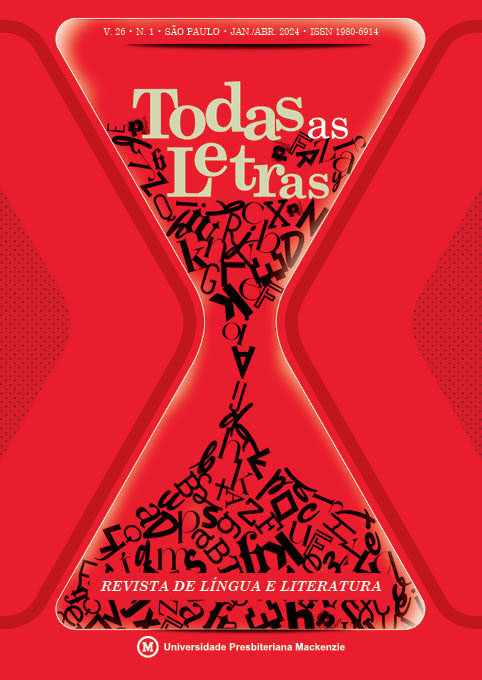The influence of sample in the ordering of causal constructions with porque and por + infinitive
Keywords:
Cause, Ordering, Sample, Porque, Por infinitiveAbstract
The causal clause with porque and por+infinitive can occur in different positions inside the causal sentence. In this article, we analyze the action of iconicity principle, the given-new principle and the domains of causality in the ordering of causal sentences with these two connectors. The results show that the causal clause tends to be postposed independently of the analyzed variables. The results also show that the particular features of the text “Atas dos brasileiros” were reflected in the results found for 19th century in general, which is an evidence of the influence of sample selection in the results of the research.
Downloads
References
BARRETO, T. M. Gramaticalização das conjunções na história do português. Tese
(Doutorado em Letras), Instituto de Letras da Universidade Federal da Bahia, 1999.
BRAGA, M. L.; PAIVA, M. C. de. Gramaticalização o e sociolinguística variacionista: o tratamento das construções introduzidas por por. In: LIMA, M. A. F. et alii. Colóquios linguísticos e literários: enfoques epistemológicos, metodológicos e descritivos. Teresina: Editora da Universidade Federal do Piauí, 2011a, p. 125-153.
_______________. Gramaticalização e gramática de construções: estabilidade e instabilidade das construções complexas de causa em tempo real. Letras & Letras, Uberlândia, MG, v. 27, 2011b, p. 51-70.
BYBEE, J.L.; BECKNER, C. Usage-based Theory. In: HEINE, B.; NARROG, H. (Eds.). The Oxford handbook of Linguistic analysis. Oxford: Oxford University Press, 2010, p. 827 - 855.
CASTRO, I. Formação da Língua Portuguesa. In: RAPOSO, E. et alii. Gramática do Português. Lisboa: Fundação Calouste Gulbenkian, 2013, p. 7 – 13.
CHAFE, W. Givenness, contrastiveness, definiteness, subjects, topics and point of view. In: LI, C. N. (ed.) Subject and topic. New York: Academic Press, 1976, p. 27 – 55.
_______________. How people use adverbial clauses. In: The proceedings of the tenth annual meeting of the Berkeley Linguistics Society. Berkeley Linguistics Society. 1984.
CLARK, H. H.; HAVILAND, S. E. Comprehension and the Given – New Contract. In: FREEDLE, R. O. (Ed.). Discourse production and comprehension. New Jersey: Ablex Publishing Corporation, 1977, p. 1 – 40.
CROFT, W. Grammatical categories: typological markedness, economy and iconicity. In: CROFT, W. Typology and Universals. Cambridge: Cambridge University Press, 1990, p. 87 – 121.
DIESSEL, H. The ordering distribution of main and adverbial clauses: a typological study. Language 77, 2001, p. 345 – 365.
___________. Competing motivations for the ordering of main and adverbial clauses. Linguistics 43, 2005, p. 449 – 470.
GOLDBERG, A. Constructions at work: the nature of generalization in language. Oxford: Oxford University Express, 2006.
HAIMAN, J. The iconicity of grammar. Language, 56, 1980, p. 515-540.
___________. Iconic and economic motivation. Language, 59, 1983, p. 781-819.
KEMMER, S.; BARLOW, M. Introduction: A Usage-based Conception of Language. In: BARLOW, M.; KEMMER, S. (Eds.) Usage based models of language. Rice University, 2000.
LABOV, W. Principles of linguistic change: internal factors. Cambridge, Oxford:
Blackwell Publishers, 1994.
LOPES, M. H. C. C. Aspectos sintácticos, semânticos e pragmáticos das construções causais: contributo para uma reflexão sobre o ensino da gramática. Tese de Doutorado, Faculdade de Letras da Universidade do Porto, 2004.
PAIVA, M. C. A. Ordenação de cláusulas causais: forma e função. Tese de doutorado em Linguística, Faculdade de Letras, UFRJ, 1991.
____________. Aspectos semânticos e discursivos da relação de causalidade. In: MACEDO, A. T. de. Variação e discurso. 1ed. Rio de Janeiro: Tempo brasileiro, 1996, p. 63 - 74.
PAIVA, M. C. A.; DUARTE, M. E. L. Mudança linguística: observações em tempo real. In: MOLLICA, M. M.; BRAGA, M. L. (orgs.) Introdução à Sociolinguística: o tratamento da variação. São Paulo: Contexto, 2003, p. 179 – 190.
PRINCE, E. F. On the given/new distinction. Papers from the 15th Regional meeting of the Chicago Linguistic Society, 1979, p. 267 – 278.
RAFAJLOVICOVÁ, R. Variation of Clause Patterns – Reordering the information in a message. In: KACMÁROVÁ, A. (ed.) English matters: a collection of papers by the Department of English language and Literature faculty. Presov: University of Presov, 2010, p. 30 - 36.
SANKOFF, D.; TAGLIAMONTE, S. S.; SMITH, E. Goldvarb X: A variable rule application for Macintosh and Windows. University of Toronto, 2005.
SANTOS, I. J. A. Mecanismos de Conexão frásica: a importância das variáveis sociais. Tese de doutorado, Instituto de Letras e Ciências Humanas, Universidade do Minho, 2016.
SCHIFFRIN, D. Multiple constraints on discourse options: a quantitative analysis of causal sequences. Discourse processes 8, 1985, p. 281 – 303.
SILVA, M. J. F. da. Propriedades sintáticas e discursivas das orações com porque. Dissertação (Mestrado em Linguística) – Faculdade de Letras, Universidade Federal do Rio de Janeiro, Rio de Janeiro, 2008.
SWEETSER, E. From etymology to pragmatics: metaphorical and cultural aspects of semantic structure. Cambridge: Cambridge University Press, 1990.
Downloads
Published
How to Cite
Issue
Section
License
Copyright (c) 2024 Mayra França Floret

This work is licensed under a Creative Commons Attribution-NonCommercial 4.0 International License.
The originals accepted and published become property of Mackenzie Presbyterian University, being forbidden their total or partial reproduction without permission of the Editorial Board, except for study and research.




